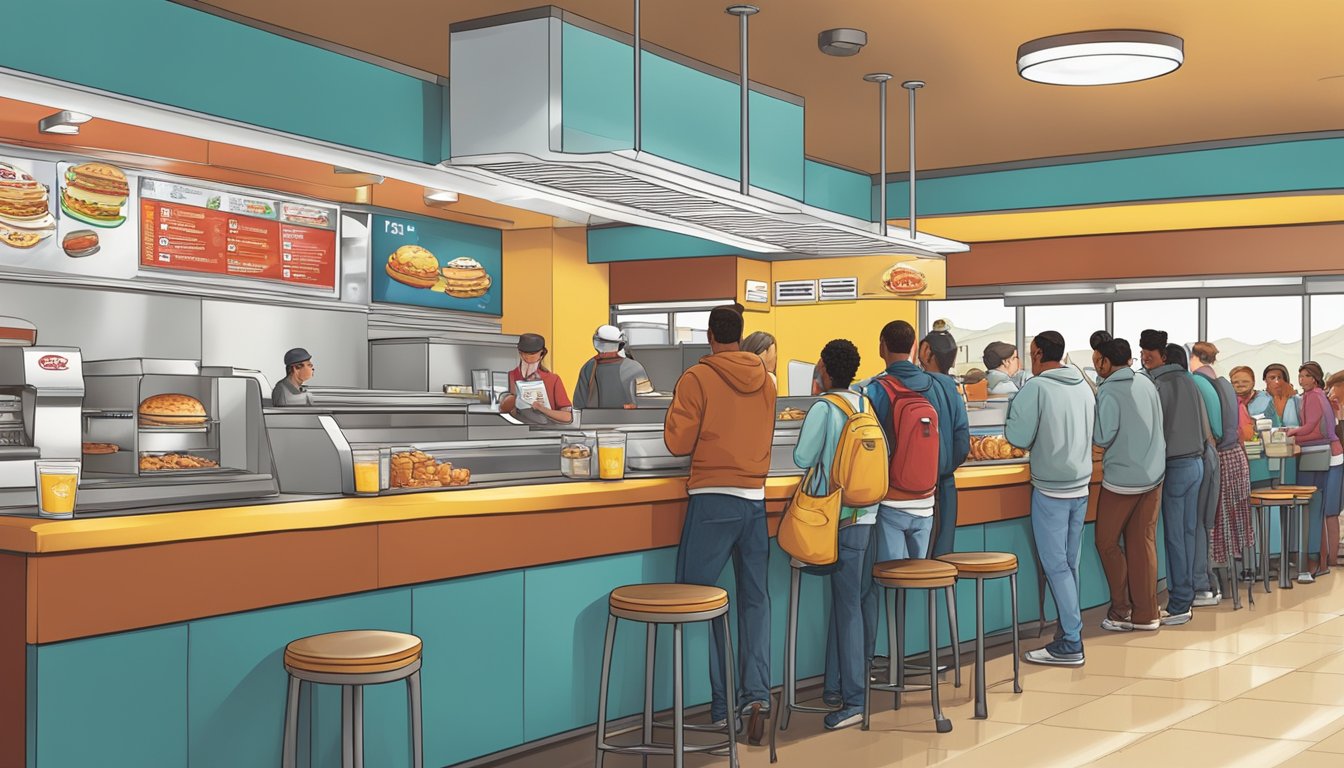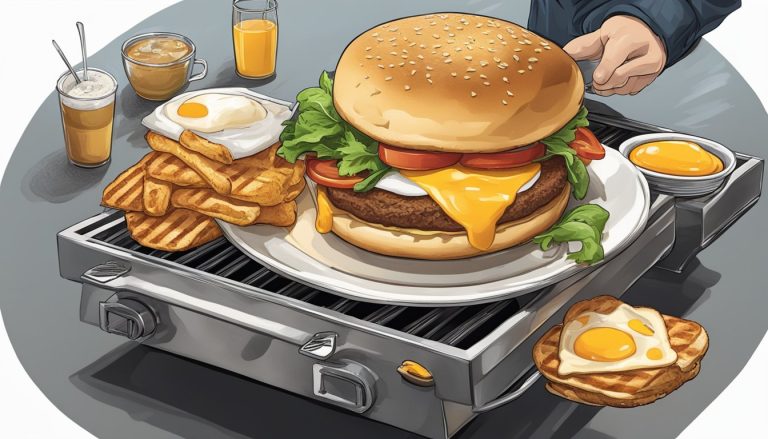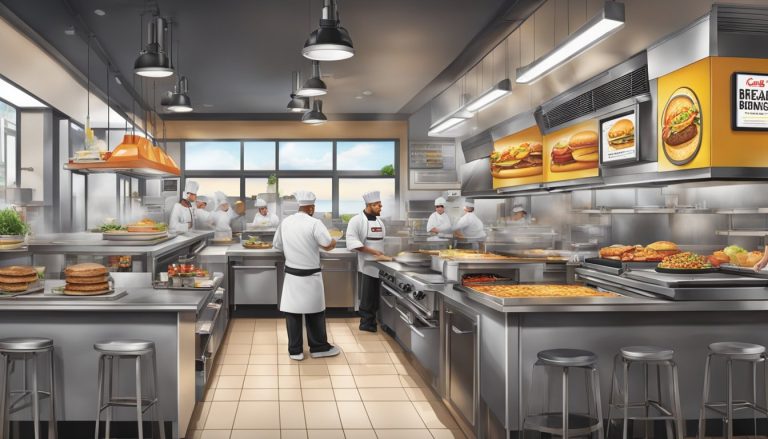Carl’s Jr. has long been a staple in the fast-food breakfast market, offering a diverse menu of morning options. From biscuit sandwiches to breakfast burritos, the chain caters to a wide range of tastes and appetites. Carl’s Jr. maintains competitive breakfast prices to attract customers in a crowded market while still aiming for profitability.
The economics of breakfast play a crucial role in Carl’s Jr.’s pricing strategy. Fast-food chains often use breakfast as a loss leader, offering low prices to draw customers in with the hope they’ll return for other meals. Carl’s Jr. balances this approach by keeping prices competitive with other higher-end fast-food restaurants while differentiating itself through menu variety and quality.
Carl’s Jr.’s breakfast pricing reflects broader economic principles at work in the fast-food industry. The chain operates in a monopolistically competitive market, where it faces pressure from both traditional fast-food rivals and newer fast-casual dining options. This competition drives Carl’s Jr. to innovate and adjust its pricing to maintain market share while covering costs.
Understanding the Fast-Food Industry
The fast-food industry in America is a dynamic and competitive landscape shaped by evolving consumer preferences and market trends. It encompasses traditional quick-service restaurants and the growing fast-casual segment, each vying for market share through menu innovation and pricing strategies.
Overview of American Fast-Food Restaurant Chain
Carl’s Jr. operates as a prominent player in the American fast-food restaurant chain sector. With over 2,000 locations in the United States and 500 globally, the brand has established a significant presence in the industry.
Carl’s Jr. is known for its diverse menu offerings and adaptability to food trends. The chain emphasizes customization options and quality ingredients to appeal to health-conscious consumers.
Co-branding strategies have allowed Carl’s Jr. to expand its market reach and product versatility. This approach helps the company maintain competitiveness in a saturated market.
The Rise of Fast-Casual Dining
Fast-casual dining has emerged as a significant disruptor in the food service industry. This segment bridges the gap between traditional fast-food and casual sit-down restaurants.
Fast-casual establishments typically offer:
- Higher quality ingredients
- Customizable menu options
- Slightly higher price points than fast-food
- More upscale ambiance
The growth of this sector has posed challenges for conventional fast-food chains. Many consumers are willing to pay a premium for perceived higher quality and healthier options.
Fast-casual dining appeals to millennials and health-conscious individuals seeking quick, yet more refined dining experiences. This trend has pushed traditional fast-food chains to innovate and improve their offerings.
Assessing the Fast-Food Market Landscape
The fast-food market is characterized by intense competition and rapidly changing consumer preferences. Key factors shaping the industry include:
- Price sensitivity: Consumers expect value for money
- Convenience: Speed of service remains crucial
- Health consciousness: Growing demand for nutritious options
- Digital integration: Mobile ordering and delivery services
Fast-food chains must navigate these factors to maintain market share. Many are investing in technology to enhance customer experience and streamline operations.
Menu innovation is critical for success. Chains frequently introduce new items to attract customers and stay relevant. Balancing menu diversity with operational efficiency is an ongoing challenge.
Brand perception plays a significant role in consumer choices. Companies invest heavily in marketing to differentiate themselves in a crowded marketplace.
Carl’s Jr.: A Historical Perspective

Carl’s Jr. has grown from humble beginnings into a major fast food chain. Its journey reflects the expansion of the American fast food industry in the post-war era.
From Hot Dog Cart to National Chain
Carl Karcher and his wife Margaret started their food business with a single hot dog cart in Los Angeles in 1941. They invested $326, using $15 cash and borrowing $311 against their car. The cart’s first day of sales totaled $14.75.
By 1945, the Karchers had expanded to a full-service restaurant called Carl’s Drive-In Barbecue in Anaheim, California. The first Carl’s Jr. restaurant opened in 1956, marking the beginning of the chain’s expansion.
Carl’s Jr. continued to innovate in the fast food space. In 1977, it became the first fast food chain to install self-serve salad bars in all its California locations. This move predated similar offerings by competitors and helped spark the salad bar trend of the 1980s.
Carl Karcher and the West Coast Influence
Carl Karcher’s vision shaped Carl’s Jr.’s identity as a West Coast brand. The chain initially focused its expansion efforts in California and other western states, building a strong regional presence.
Carl’s Jr. differentiated itself by offering higher-quality, more substantial burgers than many competitors. This approach reflected Karcher’s belief in providing value and satisfying meals to customers.
The chain’s menu innovations often aligned with West Coast food trends. In 2011, Carl’s Jr. became the first national brand to offer turkey burgers, catering to health-conscious consumers. In 2015, it introduced all-natural, antibiotic-free beef patties, further solidifying its position as a quality-focused fast food option.
Strategic Marketing Insights

Carl’s Jr. employs savvy marketing tactics to maintain its competitive edge in the breakfast market. The company focuses on understanding its target audience, crafting compelling advertisements, and leveraging social media platforms effectively.
Target Market and Consumer Preferences
Carl’s Jr. targets young, health-conscious adults seeking convenient yet satisfying breakfast options. The company’s market research reveals a preference for protein-rich meals and customizable menu items. To cater to these preferences, Carl’s Jr. offers:
- Made-to-order breakfast sandwiches
- Protein-packed options like egg white omelets
- All-day breakfast menu items
Consumer data shows a growing demand for plant-based alternatives. In response, Carl’s Jr. has introduced vegetarian breakfast options to broaden its appeal.
The chain also emphasizes value, offering competitive combo deals to attract price-sensitive customers. This strategy helps Carl’s Jr. compete effectively with rivals like Burger King in the breakfast segment.
Effective Advertising Strategies
Carl’s Jr. employs bold and attention-grabbing advertising campaigns to stand out in the crowded fast-food market. Key elements of their strategy include:
- Provocative visuals and messaging
- Celebrity endorsements
- Emphasis on product quality and taste
The company’s ads often feature close-up shots of menu items, highlighting their appetizing appearance. This approach taps into consumers’ visual cravings and encourages impulse purchases.
Carl’s Jr. also leverages humor in its campaigns, creating memorable ads that resonate with its target demographic. By aligning its marketing message with current trends and pop culture references, the chain maintains relevance among younger consumers.
Leveraging Social Media
Social media plays a crucial role in Carl’s Jr.’s marketing strategy. The company uses platforms like Instagram, Twitter, and TikTok to:
- Showcase new menu items
- Run promotional contests
- Engage directly with customers
Carl’s Jr. creates visually appealing content tailored to each platform. On Instagram, the focus is on high-quality food photography. Twitter is used for quick updates and customer service. TikTok features fun, behind-the-scenes content and user-generated challenges.
The chain also partners with social media influencers to expand its reach. These collaborations often involve influencers taste-testing new breakfast items or participating in branded challenges. This strategy helps Carl’s Jr. tap into niche audiences and build authenticity.
Product Differentiation

Carl’s Jr. employs various strategies to stand out in the competitive fast food market. The company focuses on creating unique offerings that appeal to diverse consumer tastes and preferences.
Burger Varieties and Flavor Profiles
Carl’s Jr. offers a wide range of burger options to cater to different palates. Their signature Thickburger line features 100% Black Angus beef patties in various sizes and flavor combinations. The menu includes classics like the Original Thickburger and creative options such as the Jalapeno Thickburger.
Carl’s Jr. also experiments with bold flavors and unique toppings. They’ve introduced burgers with guacamole, bacon jam, and crispy onion strings. These distinctive flavor profiles help set their products apart from competitors.
Innovations in Menu Items
Carl’s Jr. regularly introduces new and innovative menu items to keep customers interested. They’ve launched plant-based options like the Beyond Famous Star burger, catering to the growing vegetarian and flexitarian market.
The company also creates limited-time offerings to generate excitement. These may include seasonal items or collaborations with popular brands. For example, they’ve partnered with snack companies to create burgers topped with potato chips or jalapeno poppers.
Carl’s Jr. extends its innovation beyond burgers. They offer unique sides, desserts, and breakfast items to provide a comprehensive dining experience.
Maintaining Quality and Brand Image
Carl’s Jr. emphasizes quality control to maintain its reputation for premium fast food. They use high-quality ingredients like hand-breaded chicken tenders and fresh-baked buns. This commitment to quality helps justify slightly higher prices compared to some competitors.
The company’s marketing strategy reinforces its brand image as a provider of indulgent, satisfying meals. They often use provocative advertising campaigns to grab attention and appeal to their target demographic of young, hungry consumers.
Carl’s Jr. also invests in restaurant design and customer service to create a more upscale fast food experience. Clean, modern interiors and attentive staff contribute to a positive brand perception.
Maintaining a Competitive Edge

Carl’s Jr. employs various strategies to stay ahead in the fast-food industry. The company focuses on menu innovation, brand positioning, and pricing to retain its market share and attract new customers.
Upholding a Sustainable Competitive Advantage
Carl’s Jr. leverages its strong brand recognition and reputation to maintain an edge over competitors. The company continually introduces new menu items to cater to changing consumer preferences.
By offering customization options and using quality ingredients, Carl’s Jr. appeals to health-conscious customers. This approach helps differentiate the brand from other fast-food chains.
Carl’s Jr. also emphasizes exceptional customer service to build loyalty. The company invests in employee training to ensure consistent service quality across locations.
SWOT Analysis: Strengths, Weaknesses, Opportunities, Threats
Strengths:
- Strong brand recognition
- Menu innovation and variety
- Quality ingredients
Weaknesses:
- Intense competition in the fast-food sector
- Perception as less healthy than fast-casual options
Opportunities:
- Expanding into new markets
- Embracing food delivery trends
- Developing plant-based menu options
Threats:
- Changing consumer preferences towards healthier options
- Rising food and labor costs
- Increased competition from fast-casual restaurants
Competitive Pricing Strategies
Carl’s Jr. uses strategic pricing to remain competitive in the market. The company offers value meals and combo deals to attract price-sensitive customers.
To balance profitability with affordability, Carl’s Jr. employs a tiered pricing strategy. This approach allows customers to choose between budget-friendly options and premium items.
The company also runs limited-time promotions and discounts to drive traffic and encourage customers to try new menu items. These tactics help Carl’s Jr. compete with other fast-food chains while maintaining its brand positioning.
Customer Engagement and Loyalty
Carl’s Jr. employs strategic initiatives to foster strong connections with its customer base. These efforts aim to cultivate loyalty and enhance brand recognition in a competitive fast-food landscape.
Loyalty Programs and Customer Satisfaction
Carl’s Jr. implements a loyalty program that rewards frequent customers with points, discounts, and exclusive offers. This program encourages repeat visits and increases customer lifetime value. The company tracks customer preferences and purchase history to personalize promotions and menu recommendations.
Carl’s Jr. also prioritizes customer satisfaction through quality control measures and responsive customer service. They actively seek feedback through surveys and social media, using insights to improve menu items and service quality. This commitment to customer satisfaction helps build trust and loyalty among millennials and other key demographics.
Building Brand Recognition and Recall
Carl’s Jr. focuses on creating memorable brand experiences to enhance recognition and recall. They use bold flavors and unique menu items to differentiate themselves from competitors. The company’s marketing campaigns often feature eye-catching visuals and humor to increase brand memorability.
Social media plays a crucial role in Carl’s Jr.’s brand-building efforts. They engage with customers through interactive content, contests, and behind-the-scenes glimpses of their operations. This approach helps maintain a strong presence in customers’ minds and fosters a sense of connection with the brand.
Carl’s Jr. also partners with influencers and participates in community events to increase brand visibility and positive associations. These initiatives contribute to stronger brand recall when customers consider their fast-food options.
Expansion and Growth Strategies

Carl’s Jr. has pursued aggressive expansion tactics to strengthen its market position and drive growth. The company leverages multiple approaches to increase brand presence and reach new customers.
Franchise Operations and Global Reach
Carl’s Jr. relies heavily on franchising to fuel its expansion. The company has over 1,200 locations across 14 countries, with a strong presence in the United States, Mexico, and parts of Asia. Franchising allows Carl’s Jr. to tap into local market knowledge and capital while maintaining brand consistency.
In recent years, Carl’s Jr. has focused on international growth. The chain has successfully entered markets like Australia, Canada, and New Zealand. This global strategy helps diversify revenue streams and reduce reliance on any single market.
Carl’s Jr. adapts its menu and marketing to suit local tastes in new regions. For example, the company offers unique items in different countries to appeal to local preferences.
Online Ordering and Delivery Services
Carl’s Jr. has embraced digital technology to meet changing consumer demands. The company has invested in robust online ordering systems and mobile apps to make purchasing more convenient for customers.
Partnerships with third-party delivery services like Uber Eats and DoorDash have expanded Carl’s Jr.’s reach beyond traditional dine-in and drive-thru options. This allows the chain to serve customers who prefer the convenience of home delivery.
The company has also experimented with digital-only kitchens in some markets. These locations focus solely on fulfilling delivery and takeout orders, reducing overhead costs.
Partnerships and Co-Branding Initiatives
Carl’s Jr. has pursued strategic partnerships to enhance its brand and menu offerings. One notable example is the incorporation of Green Burrito, a Mexican fast-food concept, into many Carl’s Jr. locations.
This co-branding strategy allows Carl’s Jr. to offer a wider variety of menu items and appeal to customers seeking Mexican cuisine alongside traditional burgers and fries. It also helps differentiate the chain from competitors.
Carl’s Jr. has also collaborated with popular brands for limited-time menu items. These partnerships generate buzz and attract new customers while reinforcing the brand’s image as innovative and trend-aware.
Focusing on the Breakfast Niche

Carl’s Jr. has strategically positioned itself in the competitive breakfast market by offering unique menu items and adapting to consumer trends. The chain aims to stand out from other fast food restaurants through its breakfast offerings.
Evolving Breakfast Sandwich Offerings
Carl’s Jr. continuously innovates its breakfast sandwich lineup to attract customers. The chain introduced hand-breaded chicken options for breakfast, differentiating itself from competitors. These sandwiches combine crispy chicken with classic breakfast ingredients like eggs and cheese.
Carl’s Jr. also experiments with bold flavors and unique combinations. For example, they’ve offered breakfast sandwiches featuring jalapeños or spicy sauces to appeal to customers seeking bolder taste profiles.
The restaurant chain pays attention to portion sizes as well. They offer both hearty options for bigger appetites and smaller, more portable choices for customers on-the-go.
Breakfast Market Trends and Carl’s Jr.’s Approach
Carl’s Jr. closely monitors breakfast market trends to stay relevant. As consumers increasingly seek healthier options, the chain has introduced items with more nutritious ingredients. They now offer egg white alternatives and whole grain bread choices.
The company also recognizes the growing demand for all-day breakfast. In response, Carl’s Jr. has extended breakfast hours at many locations, allowing customers to enjoy breakfast items beyond traditional morning hours.
To appeal to younger demographics, Carl’s Jr. incorporates trendy ingredients into its breakfast menu. This includes items like avocado toast or breakfast bowls with quinoa or other grains.
Carl’s Jr. leverages social media to promote its breakfast offerings, often showcasing new items or limited-time promotions to generate buzz and drive customer interest.




